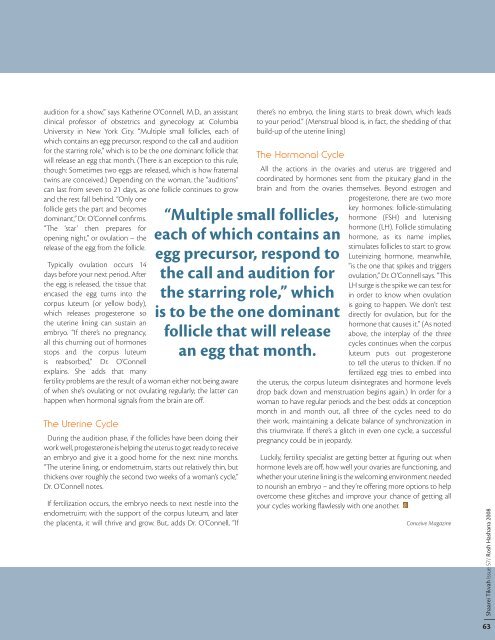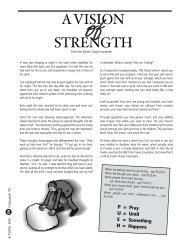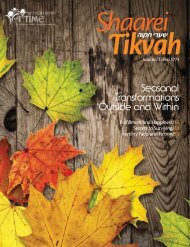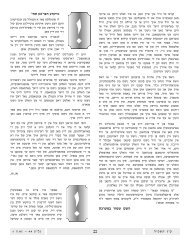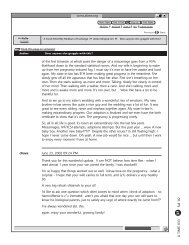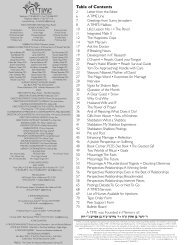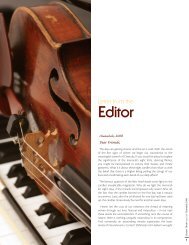Rosh Hashanah 5769/2008 - Jewish Infertility
Rosh Hashanah 5769/2008 - Jewish Infertility
Rosh Hashanah 5769/2008 - Jewish Infertility
Create successful ePaper yourself
Turn your PDF publications into a flip-book with our unique Google optimized e-Paper software.
audition for a show,” says Katherine O’Connell, M.D., an assistantclinical professor of obstetrics and gynecology at ColumbiaUniversity in New York City. “Multiple small follicles, each ofwhich contains an egg precursor, respond to the call and auditionfor the starring role,” which is to be the one dominant follicle thatwill release an egg that month. (There is an exception to this rule,though: Sometimes two eggs are released, which is how fraternaltwins are conceived.) Depending on the woman, the “auditions”can last from seven to 21 days, as one follicle continues to growand the rest fall behind. “Only onefollicle gets the part and becomesdominant,” Dr. O’Connell confirms.“The ‘star’ then prepares foropening night,” or ovulation – therelease of the egg from the follicle.Typically ovulation occurs 14days before your next period. Afterthe egg is released, the tissue thatencased the egg turns into thecorpus luteum (or yellow body),which releases progesterone sothe uterine lining can sustain anembryo. “If there’s no pregnancy,all this churning out of hormonesstops and the corpus luteumis reabsorbed,” Dr. O’Connellexplains. She adds that manyfertility problems are the result of a woman either not being awareof when she’s ovulating or not ovulating regularly; the latter canhappen when hormonal signals from the brain are off.The Uterine CycleDuring the audition phase, if the follicles have been doing theirwork well, progesterone is helping the uterus to get ready to receivean embryo and give it a good home for the next nine months.“The uterine lining, or endometruim, starts out relatively thin, butthickens over roughly the second two weeks of a woman’s cycle,”Dr. O’Connell notes.If fertilization occurs, the embryo needs to next nestle into theendometruim; with the support of the corpus luteum, and laterthe placenta, it will thrive and grow. But, adds Dr. O’Connell, “If“Multiple small follicles,each of which contains anegg precursor, respond tothe call and audition forthe starring role,” whichis to be the one dominantfollicle that will releasean egg that month.there’s no embryo, the lining starts to break down, which leadsto your period.” (Menstrual blood is, in fact, the shedding of thatbuild-up of the uterine lining)The Hormonal CycleAll the actions in the ovaries and uterus are triggered andcoordinated by hormones sent from the pituitary gland in thebrain and from the ovaries themselves. Beyond estrogen andprogesterone, there are two morekey hormones: follicle-stimulatinghormone (FSH) and lutenisinghormone (LH). Follicle stimulatinghormone, as its name implies,stimulates follicles to start to grow.Luteinizing hormone, meanwhile,“is the one that spikes and triggersovulation,” Dr. O’Connell says. “ThisLH surge is the spike we can test forin order to know when ovulationis going to happen. We don’t testdirectly for ovulation, but for thehormone that causes it.” (As notedabove, the interplay of the threecycles continues when the corpusluteum puts out progesteroneto tell the uterus to thicken. If nofertilized egg tries to embed intothe uterus, the corpus luteum disintegrates and hormone levelsdrop back down and menstruation begins again.) In order for awoman to have regular periods and the best odds at conceptionmonth in and month out, all three of the cycles need to dotheir work, maintaining a delicate balance of synchronization inthis triumvirate. If there’s a glitch in even one cycle, a successfulpregnancy could be in jeopardy.Luckily, fertility specialist are getting better at figuring out whenhormone levels are off, how well your ovaries are functioning, andwhether your uterine lining is the welcoming environment neededto nourish an embryo – and they’re offering more options to helpovercome these glitches and improve your chance of getting allyour cycles working flawlessly with one another. STConceive MagazineShaarei Tikvah Issue 57/ <strong>Rosh</strong> Hashana <strong>2008</strong>63rosh hashana_magazine2.indd 6321/09/<strong>2008</strong> 7:08:08 PM


